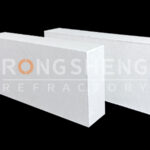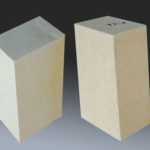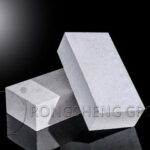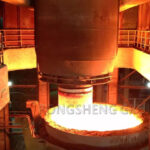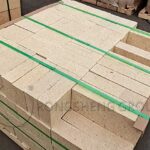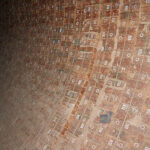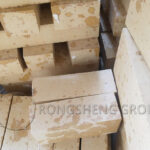Insulation bricks and refractory bricks are commonly used refractory and insulation materials in kilns and various high-temperature equipment. The main function of insulation bricks is to maintain heat and reduce heat loss.
Lightweight Insulation Bricks with High Thermal Insulation Properties
The wide application of lightweight insulation bricks not only complies with the concept of environmental protection and resource conservation but also has the advantage of industrial kilns in that the insulation of waste heat improves work efficiency and greatly saves production costs. Lightweight refractory bricks refer to refractory products with high porosity, low volume density, and low thermal conductivity. Lightweight refractory bricks are characterized by a porous structure (porosity is generally 40% to 85%) and high thermal insulation.

Mullite Lightweight Insulation Bricks
As a representative product of new energy-saving and environmentally friendly lightweight insulation bricks, mullite lightweight insulation bricks have become one of the mainstream products of insulation bricks.
What are mullite lightweight insulation bricks? What are its advantages? High-alumina refractory materials with mullite as the main crystal phase are called mullite lightweight insulation bricks. Generally, the alumina content is between 65% and 75%. In addition to mullite, the mineral composition contains a small amount of glass phase and cristobalite in those with lower alumina content; and a small amount of corundum in those with higher alumina content. The advantage of mullite lightweight insulation bricks is that they can be exposed to flames and can be directly used in high-temperature kiln linings. Mullite lightweight insulation bricks are a refractory insulation material widely used in emerging industrial kilns and high-temperature equipment.
Characteristics of Mullite Lightweight Insulation Bricks
- Low thermal conductivity and good thermal insulation effect.
- Low heat melt. Due to low thermal conductivity, the mullite series lightweight insulation bricks store very little heat energy and have obvious energy-saving effects in intermittent operation.
- Low impurity content and very low content of alkali metal and other oxides in the iron box. Therefore, the refractoriness is high; the higher aluminum content allows it to maintain good performance under a reduced atmosphere.
- High hot compressive strength.
- The appearance dimensions are precise, speeding up the masonry work and reducing the usage of refractory mud. The strength and stability of the masonry are ensured, thereby extending the life of the lining.
- It can be processed into special shapes to reduce the number of bricks and joints.
Due to these characteristics of mullite lightweight insulation bricks, we can observe that its refractoriness is relatively high, which can reach above 1790℃. The starting temperature of softening under load is 1600 ~ 1700℃. The normal temperature compressive strength is 70~260MPa. Good thermal shock resistance.
Physical and chemical indicators of mullite lightweight insulation bricks. According to the different operating temperatures, the models can be divided into seven types: MG-23, MG-25, MG-26, MG-27, MG-28, MG-30, and MG-32 series.
Combined with the physical and chemical indicators of mullite lightweight insulation bricks, it is widely used in various industrial kilns. Such as bell furnaces, heating furnaces, cracking furnaces, heat treatment furnaces, shuttle kilns, tunnel kilns, roller kilns, enamel kilns, ceilings and walls of ceramic kilns, and thermal insulation lining materials.
Specifications and dimensions of mullite lightweight insulation bricks. The most typical and commonly used size is still 230*114*65mm. It can also be accurately cut and processed into other special sizes according to work needs. So, how many mullite insulation bricks are there in one ton? Taking the standard size (230*114*65mm, body density 1.0g/cm) as an example, the weight of a single piece is about 1.7kg, so one ton is about 588 pieces.
What is the price of mullite lightweight insulation bricks? The factors that determine the price are determined by the density and size of the mullite lightweight insulation bricks. The general price is about 3800-6000 yuan. Remember to have technical exchanges with the insulation brick manufacturer before purchasing. Reduce unnecessary trouble and get the most suitable product.

Characteristics of High Alumina Poly Light Insulation Bricks
High-alumina poly light insulation brick is a new type of lightweight refractory material, which is mainly made of raw materials such as high-alumina melt and foam stabilizer through mixing, foaming, solidification, and other processes. Its main characteristics are as follows.
Lightweight performance. High-alumina lightweight thermal insulation bricks are very light in weight. Compared with traditional thermal insulation materials, their weight is only about 1/4 of that.
Good thermal insulation properties. High-alumina polylight insulation bricks have excellent thermal insulation properties, which can effectively prevent heat transfer and improve the energy efficiency of buildings.
Good resistance to cold and thermal shock. High-alumina poly-light thermal insulation bricks have good cold and thermal shock resistance, can maintain stable performance in different temperature environments, and are not easy to break or crack.
Corrosion resistance. High-alumina polylight insulation bricks have excellent corrosion resistance and can withstand the erosion of a variety of chemical substances, maintaining the stability and durability of the material.
Ease of processing. High-alumina poly-light insulation bricks can be cut, drilled, formed, etc. to facilitate construction and installation. In short, high-alumina poly-light insulation bricks have lightweight, excellent thermal insulation properties, good cold and thermal shock resistance and corrosion resistance, and are excellent thermal insulation material.

Do Lightweight Insulation Bricks Have Different Insulation Effects with Different Bulk Densities?
Lightweight insulation bricks play the role of thermal insulation, and the insulation effect is different depending on the density.
Lightweight insulation bricks are divided into different materials and different densities. At present, more clay lightweight bricks are used. If it is an insulation layer with too high a temperature, insulation bricks suitable for different temperatures must be used. If the temperature is 1000°C, clay insulation bricks can be used. If the temperature is above 1300°C, high-alumina lightweight insulation bricks should be used. If the temperature is above 1350°C, mullite insulation bricks should be used. There are also some light kilns, and the working layer of the lining is also made of lightweight bricks to reduce the weight of the kiln body. In this case, alumina hollow spherical bricks should be selected.
Whether it is clay, high alumina, or mullite, there are different body densities of 1.0, 1.2, 0.8, and 0.6. The smaller the body density, the better the insulation effect. The insulation bricks of alumina hollow balls are of 1.2 and 1.0 density. However, for some special furnace lining materials, insulation bricks with slightly higher strength should be used. Because the density is too small, the heavy bricks in the working layer will wear the insulation bricks into pieces during use. Affects the thermal insulation effect.
Of course, the density is different, and the price is not high. The smaller the density, the higher the price of the insulation bricks. Because the thermal conductivity is different depending on the size of the body density. The smaller the density of the insulation brick, the lower the thermal conductivity and the better the insulation effect. This saves more fuel during the use of the kiln body and reduces production costs.
Moreover, the smaller the density, the lower the weight of the industrial kiln. The smaller the density of the insulation bricks, the higher the price of the raw materials used, the better the insulation effect, and the price will be higher. However, in the process of selecting a lightweight insulation layer, strength must also be considered. The smaller the density of the lightweight insulation brick, the lower the strength. If the density of heavy bricks in the working layer is large, the density of lightweight bricks should still be considered. If the density of low-material insulation bricks is too high and the insulation effect is not good, then insulation bricks with higher materials should be used as the insulation layer. Otherwise, the insulation effect will be affected if the heavy bricks are ground into insulation bricks. Moreover, the heavy bricks will move as the insulation layer breaks, and the entire kiln lining needs to be replaced.
However, if the working layer uses alumina hollow ball bricks, there is no need to consider the problem of too small density. Alumina hollow ball bricks can play a thermal insulation role and can also be in direct contact with flames. It reduces the trouble of insulation layer and heavy layer, and can directly play the dual functions of insulation and use.
Therefore, the density of lightweight insulation bricks is different, and the insulation effect is also different. It is most reasonable to choose according to the kiln temperature when choosing.


